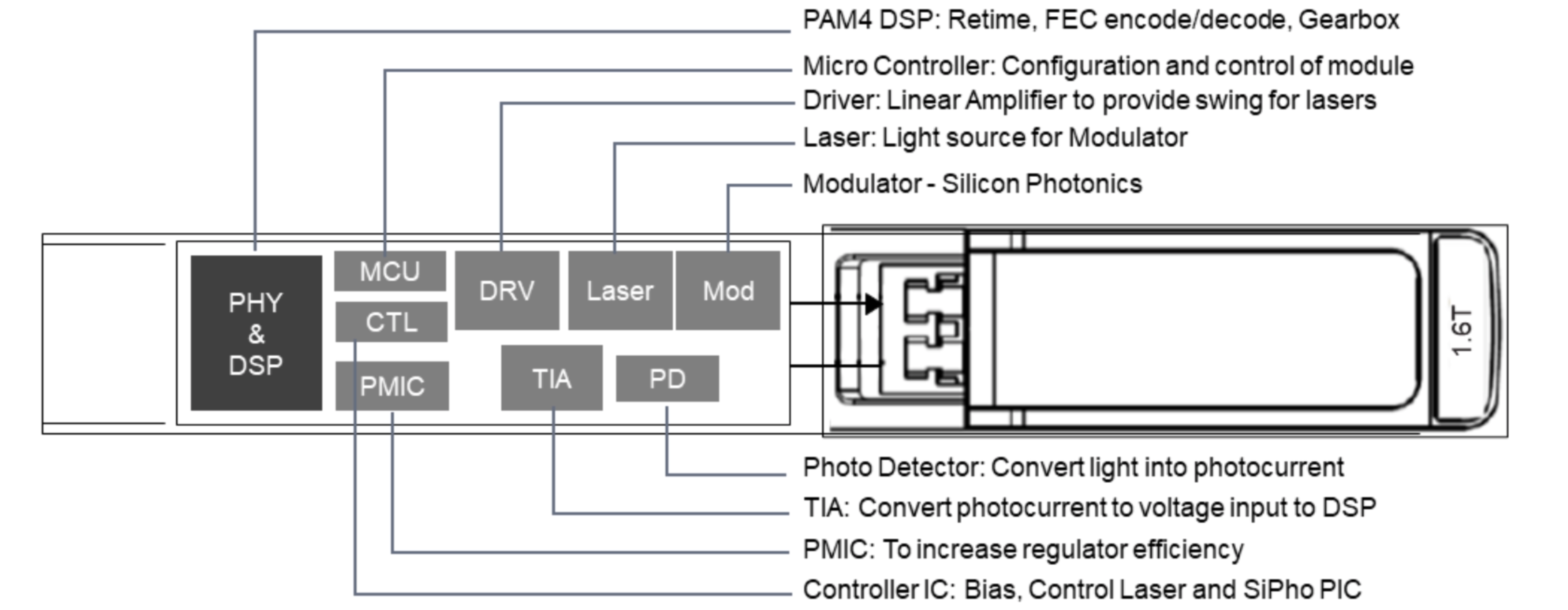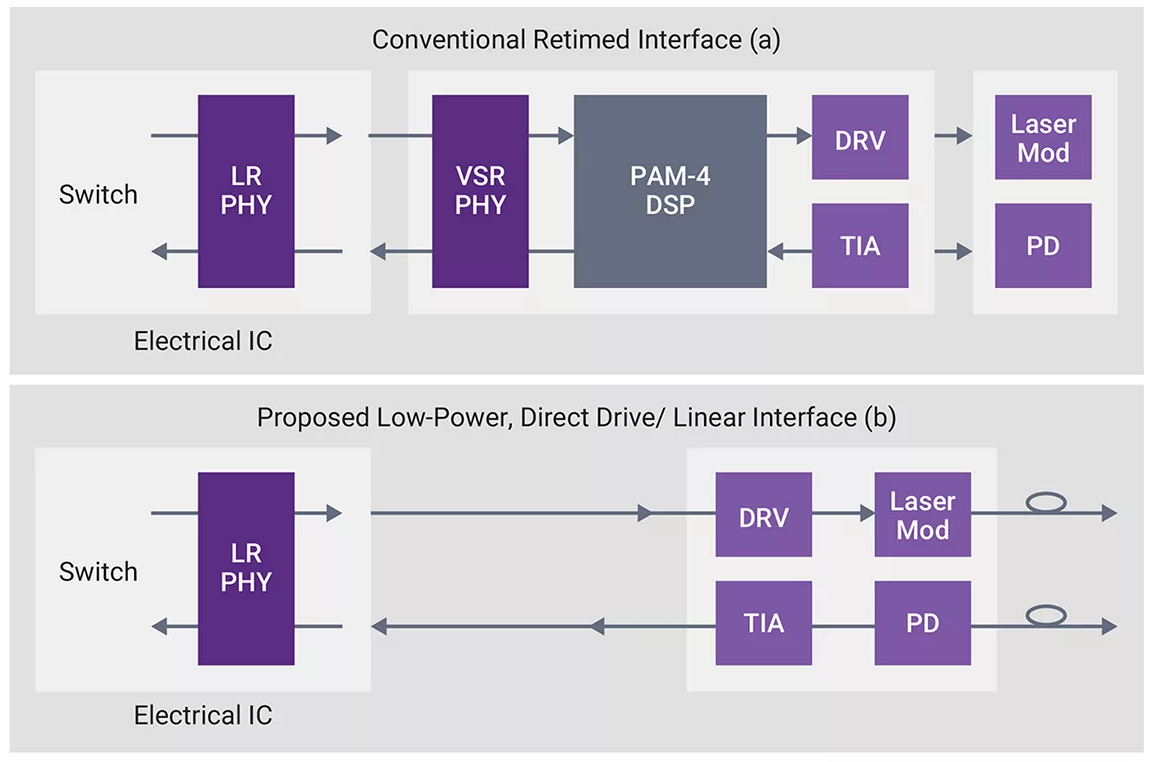Data center density continues growing, driving interconnect technology to meet new challenges. Two of the largest are signal integrity and power consumption. Optical interconnects can solve many signal integrity issues posed by copper cabling and offer support for higher frequencies and bandwidths. Still, through sheer numbers in a data center – with projected 10x interconnect growth in racks for applications like AI – optical interfaces add up quickly to pose power consumption problems. Retiming circuitry provides flexibility at the cost of added power. New linear direct-drive techniques simplify interfaces, saving energy and helping close the interconnect scalability gap. Here, we highlight Synopsys’ efforts to usher in more efficient linear pluggable optics with their 1.6T Ethernet and PCIe 7.0 IP solutions.
What’s using most of the power in a pluggable optical interface?
Pluggable modules emerged years ago as an easier way to configure (and, in theory, upgrade within controller limits) physical network interfaces. Instead of swapping motherboards or expansion cards inside a server to get different network ports, designs accommodating SFPs let IT teams choose modules and mix and match them for their needs. SFPs also helped harmonize installations with varying types of network interfaces in different platforms across the enterprise network.
The latest form factor for high-speed Ethernet is OSFP. Density increases have fostered new types of OSFPs, which gang lower-speed lanes into a faster interface. A high-level view of an OSFP pluggable optical module shows there is more than just electrical to optical conversion – analog amplifiers team with an MCU and DSP for signal processing and retiming.

Because a high-speed network interface is likely continuously transferring a data stream, the PHY is continuously retiming the incoming signal. In a single OSFP, this power use may not seem like a lot. However, in a dense data center with aggregate transport bandwidth beyond 25T switches, projections show optical pluggable modules become one of the largest power consumers in the networking subsystem. With data center energy usage a crucial consideration, more efficient pluggable optical modules become essential to attain new levels of interconnect scalability.
New SerDes technology enables direct-drive optical interfaces
The complexity in an optical module arises from the onboard (or, more accurately, on-chip) PHY’s inability to compensate for a range of optical impairments, which worsen as speeds increase. What seemed like a good idea to move retiming into the optical module now merits rethinking as power efficiency bubbles up to the top of the list of concerns. A linear direct-drive (LDD) or linear pluggable optical (LPO) interface retools the electrical circuitry, usually in a network switch ASIC inside a server or network appliance, to handle the required compensation. One result is a simpler OSFP that deals only with electrical-to-optical conversion, significantly reducing the power consumption of the retiming function in the PHY.

The tradeoff is handling direct drive functionality efficiently in next-generation, optical-ready PHY IP. Moving the logic into a network controller ASIC requires careful attention to signal integrity and dealing with reflections, crosstalk, noise, dispersion, and non-linearities. High-speed digital circuitry in a compact footprint generates significant heat, requiring sound thermal management. Shared resources in the host ASIC supporting the SerDes IP provide power management advantages over the retimed implementation.
Synopsys is carving a path toward more efficient linear pluggable optics using co-simulation techniques to develop advanced SerDes IP solutions for faster Ethernet and PCI Express. At higher data rates, simplified models of photonic behavior through electrical equivalents provide inaccurate performance estimates. With more robust electro-optical modeling, simulating IP solutions in a system context offers better results. Synopsys IP solutions first appeared in demonstrations at OFC2024 using OpenLight’s PICs.
These Synopsys IP solutions enable scale-out and scale-up SoC designs:
- A 1.6T Ethernet IP solution with multi-rate, multi-channel 1.6T Ethernet MAC and PCS controllers, 224G Ethernet PHY IP, and verification IP for easier SoC integration.
- A PCIe 7.0 IP solution with a PHY, controller, IDE security module, and verification IP providing secure data transfers up to 512 GB/sec bidirectional in x16 configurations.
The Synopsys PHY IP for 224G Ethernet and PCIe 7.0/6.x have demonstrated capabilities for linear direct drive, and the 224G Ethernet works with retimed RX and TX.
Learning more about LDD and LPO solutions
Once the industry sees the possibilities for LDD/LPO in SoC designs for server and networking hardware, the ecosystem for linear pluggable optics solutions should develop rapidly to recapture as much as 30% of the energy used in a high-interconnect density data center. Synopsys is discussing more details of its unified electronic and photonic design approach and the optical direct drive IP solutions at two real-world events:
European Conference on Optical Communication (ECOC2024)
Optica Photonic-Enabled Cloud Computing Industry Summit at Synopsys
An on-demand Synopsys webinar also offers more insight into the rising interconnect demands, the evolution of OSFPs, LDD technology, and electro-optical co-simulation techniques:
To retime or not to retime? Getting ready for PCIe and Ethernet over Linear Pluggable Optics
Share this post via:





Comments
There are no comments yet.
You must register or log in to view/post comments.